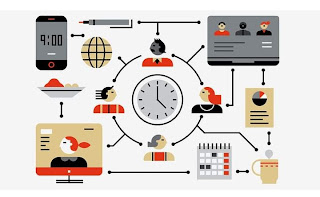As a result of technological progress, people can now work for organizations or individuals of other countries from anywhere in the world using the Internet.
This is a very common scenario when it comes to freelancing. But beyond this, people are keeping in touch with friends, relatives, colleagues and business partners in different countries at the same time and with various organizations.
But meeting and maintaining work schedules with employees in different time zones can be quite challenging when it comes to communication. Differences in time zones also lead to confusion, missed meetings and delays in communication.
According to a survey by Buffer, 40% of remote workers experience time zone confusion when working with colleagues and clients from around the world. The report, titled “The 2023 State of Remote Work,” features the experiences of 3,000 remote workers around the world.
This article offers some tips on time zone management when working abroad.
1. Understand Time Zones
According to a study by the Harvard Business Review, businesses around the world could face losses equivalent to $2 billion annually due to a lack of understanding of time zones.
So the first step when dealing with the outside world is to get the time zone right. The same time zone refers to the region where the clocks have the same time. There are now 24 time zones in the world. And they are divided by the Greenwich Mean Time (GMT) line. Time zones east of this line are ahead of GMT time and those west of this line have time zones behind GMT time.
2. Daylight Saving Time
According to a survey by the European Union Commission, 84 percent of European countries have DST or
Daylight Saving Time is used. The poll, conducted from July 4 to August 16, 2018, received 4.6 million responses from people in 28 member states. It was the largest survey conducted by the commission on public opinion.
So it is necessary to have a clear understanding about Daylight Saving Time (DST). To allow for more daylight hours, clocks are advanced one hour during the summer months. This is daylight
Known as Saving Time.
Not all countries follow this rule. Countries that follow this rule also start and end DST at different times.
3. Use The Time Zone Converter
According to a survey by the International Association of Conference Interpreters, 85 percent of participants use a time zone converter to find the correct time for meeting schedules. And 78 percent of participants said the converter helped them reduce schedule errors.
Knowing the time zone of all participants is important to schedule a meeting or event. Time zone converter can help you to know the exact time of meetings and events. There are a variety of time zone converters online that can help you quickly find the time of a meeting in your time zone.
4. Create The Same Time Zone
A Harvard Business Review study found that teams that used a reference time zone to set meeting times saw a 72 percent increase in meeting attendance and a 65 percent reduction in meeting scheduling errors.
So one way to reduce confusion is to fix a time zone in advance. If you work with people from different regions in different time zones, you may want to consider setting a common time zone that everyone can work with. This keeps everyone working at the same time and makes maintaining schedules and communications easier.
5. Be Clear About The Timing Of The Meeting
In a Doodle survey, 69 percent of participants said they miss meetings at various times due to time zone confusion. So while fixing the meeting schedule the time and time zone of the meeting should be specified.
By doing this, everyone will understand when the meeting will start. Then no one will be confused about the time zone. You can also take help of tools like calendar or clock. By doing this, the participants will understand the time of the meeting at a glance.
6. Don’t Schedule Meetings Out Of Time
According to a study by the US National Sleep Foundation, sleeping at irregular times impairs mental performance and overall well-being.
So time zone should be taken into account while scheduling the meeting so that the meeting is not scheduled while the participants are sleeping.
For example, if you live in Dhaka and want to schedule a meeting with someone in New York, definitely don’t schedule it at 3 p.m. Schedule the meeting in a way that is convenient for everyone.
7. Plan Ahead
A Harvard Business Review survey found that 70 percent of professionals working across time zones believe that planning ahead is the key to success in time zone management.
When working with people from different countries, calculate the time zone difference with everyone in advance and plan accordingly. If you have a deadline at work or an event coming up, be sure to keep the time zone in mind when planning. This will give your team and you enough time to prepare.
8. Use Different Means Of Communication
Tools like e-mail, messaging, and video conferencing are essential for remote workers to stay connected and productive.
According to one study, 82 percent of teams that work virtually say they use these mediums daily. And 61 percent of remote workers say they feel more connected to their colleagues when they use these mediums.
9. Be Respectful Of Different Time Zones
Teams that work across time zone differences are more likely to meet deadlines and work goals. Everyone should be respectful of time zone differences. Remember, everyone works according to their own schedule and everyone may have other workloads. Therefore, before fixing the time of meeting or any event, it should be discussed with everyone.
Finally, dealing with different time zones while working with someone overseas is certainly challenging. But with proper planning and communication it can be done successfully.


